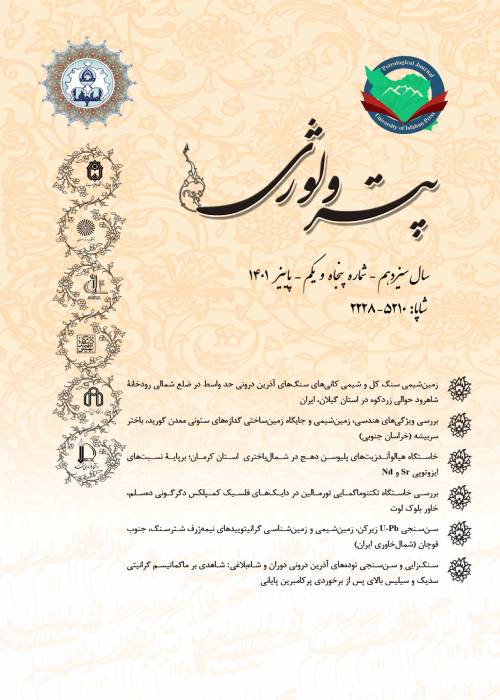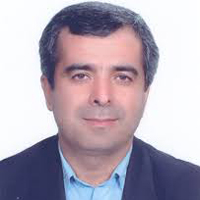Evaluation of Cu-mineralization potential based on mineralogical and geochemical evidence in Kahdelan area, Eastern Azerbaijan, NW of Iran
The Kahdelan area in the SW of Sarab is situated in the northern part of the Urumieh–Dokhtar geotectonic zone and Tarom-Hashtjin metallogenic zone. Some of the most important porphyry Cu ± Mo ± Au mineralizations in Iran occur along the NW–SE trending Urumieh–Dokhtar volcano-plutonic belt, lying between the Sanandaj–Sirjan zone and Central Iran. The Urumieh–Dokhtar magmatic arc, extends over a strike length of about 2000 km from northwest to southeast and is characterized by subduction-related calc-alkaline rocks. Due to extensive Tertiary magmatism and extensive alterations, this zone is one of the remarkable Cu-bearing regions in Iran. Therefore, many studies, regarding different aspects of the area, have been carried out by the Geological Survey of Iran as well as some private companies. Differentiating fertile and barren intrusive bodies could be important factors in reducing exploration expenses, and it is possible to identify susceptible areas by using geochemical data. Thus, the main purpose of the present study is to evaluate the granitoid rocks of the Kahdelan area as the possible potential for Cu-mineralization based on mineralogical and geochemical evidence.
Regional Geology:
The main intrusions of the Kahdelan area are Oligocene granitoid bodies composed of syenite, quartz syenite, and monzosyenite with light color and granular texture. Syenites are the most dominant plutonic rocks and quartz-syenites are the main host of Cu-mineralization. These intrusive bodies intruded the Upper Eocene pyroclastic and volcanic rocks which gave rise to alteration and mineralization occurrences in the area. Volcanic rocks are composed of basalt, basaltic-andesite, andesite, and trachyte mainly with porphyritic texture.
The present study evaluates the copper mineralization potential of the Kahdelan area for the first time. The represented information can be divided into three parts: 1) ore mineralogy and mineralogy of the Kahdelan’s rocks; 2) the investigating data related to I-type and magnetite series, and 3) the relationship between the obtained mineralogical and geochemical data with Cu-mineralization in the area to compare with porphyry copper deposits along the Urumieh–Dokhtar magmatic arc.
The dominant alteration zones in the area under study are argillic, phyllic, carbonatization, silicification, and hematitization. The primary ore minerals are magnetite, chalcopyrite, and bornite which are generally replaced by secondary minerals including chalcocite, covellite, and malachite. The ore textures are predominantly disseminated, open space-filling, replacement, and brecciated. Gangues (carbonate and quartz minerals) textures are crystalline, open space-filling, cementation of brecciated zones, and colloform.The volcanic rocks of the Kahdelan area are calk-alkaline to shoshonitic and the granitoids are shoshonitic affinity and I-Type nature (magnetite series). In the area of study, sinking solutions washed away most of the pyrites and left behind empty pyrite molds and iron oxides and hydroxides along with different amounts of malachite and neotocite. As the chondrite-normalized REE diagrams display the studied granitoids are enriched in LREEs and fairly depleted in LREEs relative to HREEs The enrichment of LILE elements and depletion of HFSE elements are features similar to those of the fertile granitoids. The rate of decline of the slope in the diagram is similar to that of the copper porphyry deposits also slightly negative Eu anomalies of these granitoids are similar to fertile granitoids (Karimpour et al., 2021). The (La/Yb)n and Eu/Eu* are used in evaluating the oxidation state and investigating the depth changes of parent magma of granitoids. The (La/Yb)n anomalies vary from 4.05-23.17, and Eu/Eu* anomalies vary from 0.32-2.65 with an average of 0.8 that are different from copper porphyry deposits.Based on spider diagrams, the depletion of titanium could be related to the low oxygen fugacity in subduction zones. The Pb and U enrichment point to the role of the earth’s crust in the petrogenesis of these rocks. P depletion could be the consequence of apatite crystallization from the parent magma.Based on the relationship between geochemical data as well as mineralization, three diagrams have been used to distinguish fertile granitoids. The Eu/Eu* versus (La/Yb)n diagram (Karimpour et al., 2021) shows that Kahdelan’s granitoids have a reduced nature. The SiO2-K2O diagram (Peccerillo and Taylor, 1976) points out that the intrusive and the volcanic rocks of Kahdalan are characterized by the much less SiO2 amount compared to fertile granitoids in SNJMB (Saveh-Nain-Jiroft Magmatic Belt) (Karimpour et al., 2021). On A/NK versus A/CNK diagram (Meinert, 1995) the granitoids under study are close to fertile copper porphyry deposits.
On the basis of mineralogical and geochemical data, Kahdelan’s intrusive rocks are I-type and magnetite series. The tectonomagmatic setting of the rocks under study lies within Volcanic Arc Granites (VAG), active continental margins, and arc systems. On A/NK versus A/CNK diagram, these granitoids are close to fertile copper porphyry deposits. Quartz syenites are the main mineralization hosts. Based on geochemical data, the average Cu content is 3492.76 ppm in a total of 170 samples collected all over the area and up to 230534 ppm Cu in mineralized Quartz syenites veinlets. Mineralogical, geochemical, and alteration data in combination with fertile–barren discrimination diagrams indicate that the granitoids of the Kahdelan area can be evaluated as the possible potential for Cu mineralization.
- حق عضویت دریافتی صرف حمایت از نشریات عضو و نگهداری، تکمیل و توسعه مگیران میشود.
- پرداخت حق اشتراک و دانلود مقالات اجازه بازنشر آن در سایر رسانههای چاپی و دیجیتال را به کاربر نمیدهد.



